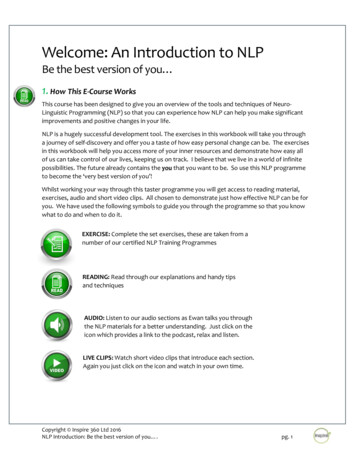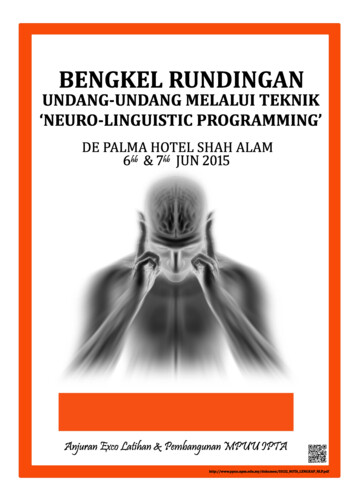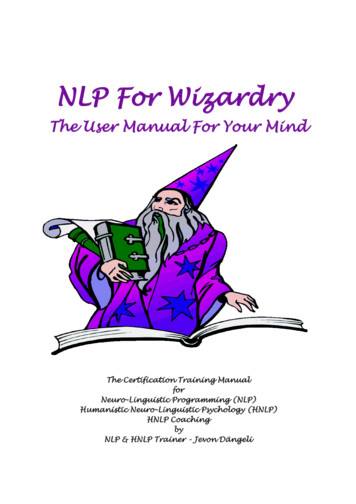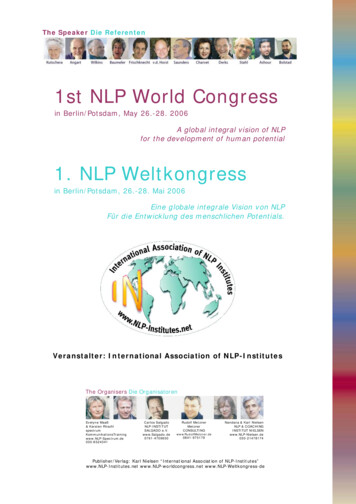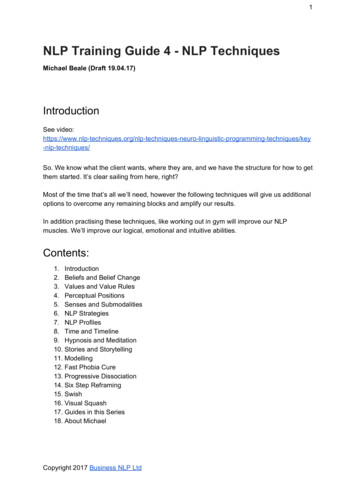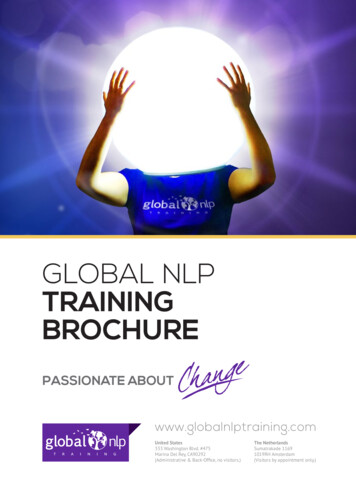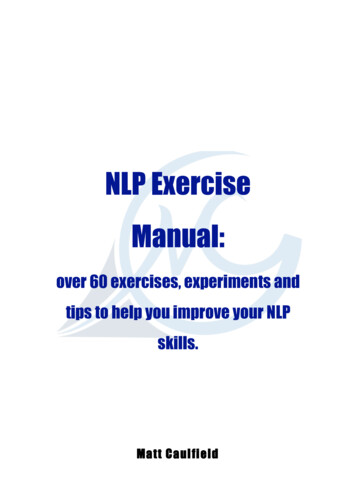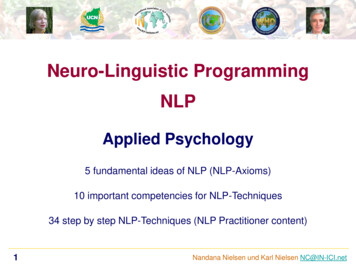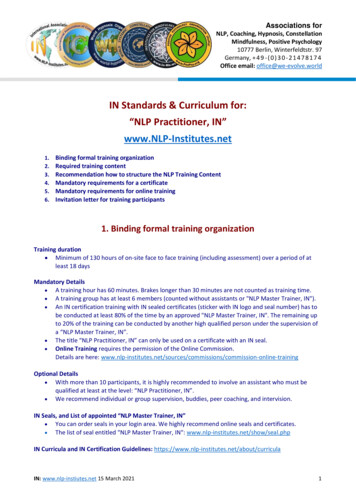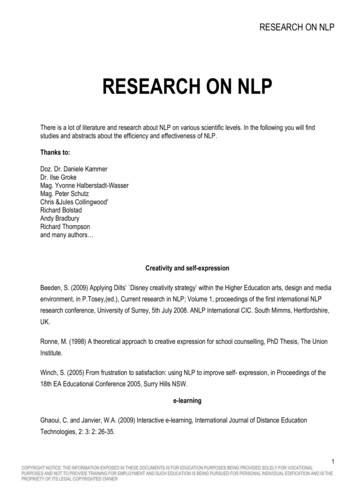
Transcription
RESEARCH ON NLPRESEARCH ON NLPThere is a lot of literature and research about NLP on various scientific levels. In the following you will findstudies and abstracts about the efficiency and effectiveness of NLP.Thanks to:Doz. Dr. Daniele KammerDr. Ilse GrokeMag. Yvonne Halberstadt-WasserMag. Peter SchutzChris &Jules Collingwood'Richard BolstadAndy BradburyRichard Thompsonand many authors Creativity and self-expressionBeeden, S. (2009) Applying Dilts’ Disney creativity strategy’ within the Higher Education arts, design and mediaenvironment, in P.Tosey,(ed.), Current research in NLP; Volume 1, proceedings of the first international NLPresearch conference, University of Surrey, 5th July 2008. ANLP International CIC. South Mimms, Hertfordshire,UK.Ronne, M. (1998) A theoretical approach to creative expression for school counselling, PhD Thesis, The UnionInstitute.Winch, S. (2005) From frustration to satisfaction: using NLP to improve self- expression, in Proceedings of the18th EA Educational Conference 2005, Surry Hills NSW.e-learningGhaoui, C. and Janvier, W.A. (2009) Interactive e-learning, International Journal of Distance EducationTechnologies, 2: 3: 2: 26-35.1COPYRIGHT NOTICE: THE INFORMATION EXPOSED IN THESE DOCUMENTS IS FOR EDUCATION PURPOSES BEING PROVIDED SOLELY FOR VOCATIONALPURPOSES AND NOT TO PROVIDE TRAINING FOR EMPLOYMENT AND SUCH EDUCATION IS BEING PURSUED FOR PERSONAL INDIVIDUAL EDIFICATION AND IS THEPROPRIETY OF ITS LEGAL COPYRIGHTED OWNER
RESEARCH ON NLPSheridan, R.D. (2008) Teaching the elderly effective learning strategies in relation to internet use, PhD Thesis,University of Brighton.Zhang, N. and Ward, A.E. (2004) On the adaption of e-learning content to learner NLP input sensory preference,International Conference on Innovation, Good Practice and Research in Engineering Education, 131-137,Wolverhampton, 3-4, June.Emotional, social, behavioural and learning difficultiesBeaver, R. (1989) Neuro-Linguistic programme as practised by an educational psychologist, Association ofEducational Psychologists Journal, 5: 2: 87-90.Bull, L. (2007) Sunflower therapy for children with specific learning difficulties (dyslexia): a randomised,controlled trial, Complementary therapies in clinical practice, 13: 1: 15-24.Childers, J.H. (1989) Looking at yourself through loving eyes, Elementary School Guidance and Counseling, 23:3: 204-209.Esterbrook, R.L. (2006) Introducing Russian Neuro-Linguistic Programming behavior modification techniques toenhance learning and coping skills for high-risk students in community colleges: an initial investigation, DoctoralDissertation, George Mason University, Fairfax VA.Fruchter, H.J. (1983) Sensory reinforcement in the service of aggression maintenance in children: a treatmentstudy, Dissertation Abstracts International 45(3) 1013-B Syracuse University.Renwich, F. (2005) The ‘A Quiet Place’ programme: Short-term support for pupils with social, emotional andbehavioural difficulties in mainstream schools, Educational and Child Psychology, The British PsychologicalSociety, 22: 3: 78-88.Squirrel, L. (2009) Can Neuro-Linguistic Programming work with young children who display varying Social,Emotional and Behavioural Difficulties?, in P.Tosey (ed.), Current research in NLP; vol 1: proceedings of the firstinternational NLP research conference, University of Surrey, 5th July 2008, South Mimms, Hertfordshire: ANLPInternational CIC.English as a foreign languageHarris, T. (2001) NLP if it works use it . . ., CAUCE, Revista de Filología y su Didáctica, 24: 29-38.2COPYRIGHT NOTICE: THE INFORMATION EXPOSED IN THESE DOCUMENTS IS FOR EDUCATION PURPOSES BEING PROVIDED SOLELY FOR VOCATIONALPURPOSES AND NOT TO PROVIDE TRAINING FOR EMPLOYMENT AND SUCH EDUCATION IS BEING PURSUED FOR PERSONAL INDIVIDUAL EDIFICATION AND IS THEPROPRIETY OF ITS LEGAL COPYRIGHTED OWNER
RESEARCH ON NLPKnowles, J. (1983) The old brain, the new mirror: matching teaching and learning styles in foreign language class(based on Neuro-Linguistic Programming), Paper presented at the Northeast Conference on the Teaching ofForeign Languages, Baltimore, MD, April 28th -May 1st 1983.Further and Higher educationJohnson, S. (2004) ‘Strategies for success’: integrating Neuro Linguistic Programming into the undergraduatecurriculum, paper presented at The 12th Improving Student Learning Symposium, Oxford Centre for Staff andLearning Development, Oxford Brookes University, Birmingham, 6-8 September.Murray, P. and Murray, S. (2007) Promoting sustainability values within career-oriented degree programmes: acase study analysis, International Journal of Sustainability in Higher Education, 8: 16-300.Skinner, H. and Croft, R. (2009) Neuro-Linguistic Programming techniques to improve the self-efficacy ofundergraduate dissertation students, Journal of Applied Research in Higher Education, 1: 1: 9-38.Language and learningEckstein, D. (2004) Reframing as an innovative educational technique: turning a perceived inability into an asset,Korean Journal of Thinking and Problem Solving, 14: 1: 37-47.Marcello, M. (2003) Language and identity: learning and the learner, paper presented at the Tenth InternationalLiteracy and Education Research Network Conference on Learning. Institute of Education, University of London15th – 18th July 2003.Mathison, J. (2004) The inner life of words: an investigation into language in learning and teaching, PhD thesis,University of Surrey.Mathison, J. and Tosey, P. (2008c) Riding into Transformative Learning, Journal of Consciousness Studies, 15:2: 67-88.McCabe, D. (1985) Meeting language needs of all types of learners, Academic Therapy, 20: 5: 563-567.Millrood, R. (2004) The role of NLP in teachers' classroom discourse, ELT Journal, 58: 10-37.Leadership and management in education and in generalDowlen, A. (1996) NLP - help or hype? Investigating the uses of neuro-Linguistic Programming in managementlearning, Career Development International, 1: 27-34.3COPYRIGHT NOTICE: THE INFORMATION EXPOSED IN THESE DOCUMENTS IS FOR EDUCATION PURPOSES BEING PROVIDED SOLELY FOR VOCATIONALPURPOSES AND NOT TO PROVIDE TRAINING FOR EMPLOYMENT AND SUCH EDUCATION IS BEING PURSUED FOR PERSONAL INDIVIDUAL EDIFICATION AND IS THEPROPRIETY OF ITS LEGAL COPYRIGHTED OWNER
RESEARCH ON NLPHelm, D.J. (1994) Neuro-Linguistic Programming: establishing rapport between school administrators and thestudents, staff and community, Education, 114: 4: 625-627.Hutchinson, G, Churches, R. and Vitae, D. (2006) The consultant leader programme in London’s PRUs and EBDschools; impact report 3: towards system leadership, Reading: CfBT Education Trust and the National Collegefor School Leadership.Hutchinson, G., Churches, R. and Vitae, D. (2007) NCSL London Leadership Strategy, consultant leaders tosupport leadership capacity in London’s PRUs and EBD Schools: impact report: roll-out, July 2007, Reading:CfBT Education Trust and the National College for School Leadership.Hutchinson, G., Churches, R. and Vitae, D. (2008)Together we have made a difference: consultant leaders tosupport leadership capacity in London’s PRUs and EBD schools, final programme report, Reading: CfBTEducation Trust and the National College for School Leadership, San Diego, California: Jensen Learning.Jones, J. and Attfield, R. (2007) Flying high: some leadership lessons from the Fast Track teaching programme,Reading: CfBT Education Trust. Unpublished.Young, J. A. (1995) Developing leadership from within: a descriptive study of the use of NeurolinguisticProgramming practices in a course on leadership, Dissertation, Ohio State University, Abstracts InternationalSection A: Humanities and Social Sciences. Vol 56 (1-A).Meta programs in the classroomBrown, N. (2002) Meta program patterns in accounting educators at a UK business school, AccountingEducation, 11: 79-91.Brown, N. (2003) A comparison of the dominant meta program patterns in accounting undergraduate studentsand accounting lecturers at a UK business school, Accounting Education, 12: 159-175.Brown, N. (2004) What makes a good educator? The relevance of meta programs, Assessment and Evaluationin Higher Education, 29: 5: 515-533.Brown, N. and Graff, M. (2004) Student performance in business and accounting subjects as measured byassessment results: an exploration of the relevance of personality traits, identified using metaprograms, International Journal of Management Education, 4: 3-18.Modelling4COPYRIGHT NOTICE: THE INFORMATION EXPOSED IN THESE DOCUMENTS IS FOR EDUCATION PURPOSES BEING PROVIDED SOLELY FOR VOCATIONALPURPOSES AND NOT TO PROVIDE TRAINING FOR EMPLOYMENT AND SUCH EDUCATION IS BEING PURSUED FOR PERSONAL INDIVIDUAL EDIFICATION AND IS THEPROPRIETY OF ITS LEGAL COPYRIGHTED OWNER
RESEARCH ON NLPDay, T. (2005) NLP modelling in the classroom: students modelling the good practice of other students, paperpresented at the British Educational Research Association New Researchers/Student Conference, University ofGlamorgan, 14th September 2005.Day, T. (2008a) A study of a small-scale classroom intervention that uses an adapted Neuro-LinguisticProgramming modelling approach, PhD Thesis, University of Bath.ParentsMunaker, S. (1997) The great aha! a path to transformation, PhD Dissertation, Abstracts International Section A:Humanities and Social Sciences. Vol 57(11-A), May 1997.Outdoor educationLee, A. (1993) Outdoor education and Neuro-Linguistic Programming, Journal of Adventure Education andOutdoor Leadership, 10: 16-17.ParentsBrandis, (1987) A neurolinguistic treatment for reducing parental anger responses and creating more resourcefulbehavioral options, California School of Professional Psychology, Los Angeles, Dissertation Abstract DissertationAbstracts International. Vol 47(11-B), May 1987.De Mirandi, C.T., de Paula, C.S., Palma, D., da Silva, E.M., Martin, D. and de Nobriga, F.J. (1999) Impact of theapplication of neurolinguistic programming to mothers of children enrolled in a day care center of ashantytown, Sao Paulo Medical Journal, 4: 117(2): 63-71.Hall, E., Wall, K., Higgins, S., Stephen, L., Pooley and Welham, J. (2005) Learning to learn with parents: lessonsfrom two research projects, Improving Schools, 8: 179-191.Peer counselingDailey, A.L. (1989) Neuro Linguistic Programming in peer counselor education, Journal of College StudentDevelopment, 30: 2: 173-175.Research methodology and NLPMathison, J. and Tosey, P. (2008a) Innovations in constructivist research: NLP, psycho-phenomenology and theexploration of inner landscapes,The Psychotherapist, 37: 5-8.5COPYRIGHT NOTICE: THE INFORMATION EXPOSED IN THESE DOCUMENTS IS FOR EDUCATION PURPOSES BEING PROVIDED SOLELY FOR VOCATIONALPURPOSES AND NOT TO PROVIDE TRAINING FOR EMPLOYMENT AND SUCH EDUCATION IS BEING PURSUED FOR PERSONAL INDIVIDUAL EDIFICATION AND IS THEPROPRIETY OF ITS LEGAL COPYRIGHTED OWNER
RESEARCH ON NLPMathison, J. and Tosey, P. (2008b) Exploring inner landscapes: NLP and psycho-phenomenology as innovationsin researching first-person experience, Qualitative Research in Management and Organization Conference, NewMexico, March 11th -13th 2008.Steinfield, T.R. and Ben-Avie, M. (2006) A Brief Discussion of the Usefulness of NLP in Action-Based EducationResearch. Paper presented at the NLP and research: a symposium, Surrey University School of Management,University of Surrey, 16th June 2006.Spelling strategyLoiselle F. (1985) The effect of eye placement on orthographic memorization, PH.D. Thesis, Faculté desSciences Sociales, Université de Moncton, New Brunswick, Canada.Malloy, T.E. (1987) Teaching integrated thought. Techniques and data, Paper presented at Annual Meeting ofthe Conference on College Composition and Communication 19th-12th March. Available at ERIC.Malloy, T.E. (1989) Principles for teaching cognitive strategies, University of Utah, available atwww.kattmodel.se.Malloy, T.E. (1995) Empirical evaluation of the effectiveness of a visual spelling strategy, in K.H. Schick (ed),Rechtschreibtherapie, Paderborn, Junfermann Verlag.Teacher perspectives and developmentCarey, J., Churches, R., Hutchinson, G., Jones, J. and Tosey, P. (2009) Neuro-Linguistic Programming andlearning: teacher case studies on the impact of NLP in education, Reading: CfBT Education Trust.Churches, R. and West-Burnham (2008) Leading learning through relationships: the implications of NeuroLinguistic Programming for personalisation and the Children’s Agenda in England, Reading: CfBT EducationTrust.Churches, R. and West-Burnham, J. (2009) Leading learning through relationships: the implications of NeuroLinguistic Programming for personalisation and the Children’s Agenda in England, in P. Tosey, P. (ed.), Currentresearch in NLP, vol 1: proceedings of the first international NLP research conference, University of Surrey, 5thJuly 2008, South Mimms, Hertfordshire: ANLP International CIC, pp.126-136.Dragovic, T. (2007) Teachers' professional identity and the role of CPD in its creation - a report on a study intohow NLP and non-NLP trained teachers in Slovenia talk about their professional identity and their work,6COPYRIGHT NOTICE: THE INFORMATION EXPOSED IN THESE DOCUMENTS IS FOR EDUCATION PURPOSES BEING PROVIDED SOLELY FOR VOCATIONALPURPOSES AND NOT TO PROVIDE TRAINING FOR EMPLOYMENT AND SUCH EDUCATION IS BEING PURSUED FOR PERSONAL INDIVIDUAL EDIFICATION AND IS THEPROPRIETY OF ITS LEGAL COPYRIGHTED OWNER
RESEARCH ON NLPInternational Society for Teacher Education, 27th Annual International Seminar at University of Stirling, Scotland,24th –30th June 2007.Teaching and learning in generalChilders, J.H. (1985) Neuro-Linguistic Programming: enhancing teacher-student communications, Journal ofHumanistic Counseling, Education and Development, 24: 1: 32-39.Dolnick, K. (2006) Neuro-Linguistic applications to classroom management: reach them to teach them, PhDThesis, Capella University.Girija Navaneedhan, C. and Saraladevi Devi, K. (2009) Influence of learning techniques on informationprocessing, US-China Education Review, 6: 1 (Serial No.50): 1-32.Helm, D.J. (1989) Education: the wagon train to the stars/it’s time to jump start’ learning throughNLP’, Education, 110: 2: 54-256.Helm, D.J. (1990) Neurolinguistic Programming: equality as to distribution of learning modalities, Journal ofInstructional Psychology, 17: 3: 159-160.Helm, D.J. (1991) Neurolinguistic Programming: gender and the learning modalities create inequalities inlearning: a proposal to reestablish equality and promote new levels of achievement in education, Journal ofInstructional Psychology, 18: 3: 167-169.Helm, D.J. (2000) Neuro-Linguistic Programming: enhancing learning for the visually impaired, Education, 120:5: 790-794.Hillin, H.H. (1982) Effects of a rapport method and chemical dependency workshop for adults employed inKansas service agencies, Dissertation Abstracts International 44(12), 3574-A, Kansas State University.Kennedy, C. and And, O. (1994) Study strategies: a formula for exceptional outcomes in the mainstream, paperpresented at the Annual Convention of the Council for Exceptional Children, 72nd, Denver, CO, April 6th –10th,1994.Parr, G. and And, O. (1986) The effectiveness of Neurolinguisitc Programming in a small-group setting, Journalof College Student Personnel, 27: 358-361.7COPYRIGHT NOTICE: THE INFORMATION EXPOSED IN THESE DOCUMENTS IS FOR EDUCATION PURPOSES BEING PROVIDED SOLELY FOR VOCATIONALPURPOSES AND NOT TO PROVIDE TRAINING FOR EMPLOYMENT AND SUCH EDUCATION IS BEING PURSUED FOR PERSONAL INDIVIDUAL EDIFICATION AND IS THEPROPRIETY OF ITS LEGAL COPYRIGHTED OWNER
RESEARCH ON NLPRagan, J. and Ragan, T. (1982) Working effectively with people: contributions of neurolinguistic Programming(NLP) to visual literacy, paper presented at the Annual Meeting of the International Visual Literacy Association(13th, Lexington, KY, October 31st - November 3rd, in Journal of Visual Verbal Languaging, 2: 2: 67-79.Raja, R. and Tien, N. (2009) Exploring multi-modality tools of Neuro-Linguistic Programming (NLP) to facilitatebetter learning among primary school students National Institute of Education, Singapore, RedesigningPedagogy, International Conference 1-3 June.Sandhu, D.S. (1994) Suggestopedia and Neurolinguistic Programming: introduction to whole brain teaching andpsychotherapy, Journal of Accelerative Learning and Teaching, 19: 3: 229-240.Schaefer, J. and Schajor, S. (1999) Learning with all one's senses: Neurolinguistic Programming in the teachingof pediatric nursing, Kinderkrankenschwester, 18: 7: 289-91.Stanton, H. E. (1989) Using Neuro-Linguistic Programming in the schools, Journal of the Society for AccelerativeLearning and Teaching, 14: 4: 311-326.Stanton, H. E. (1998) Reducing test anxiety by a combination of hypnosis and NLP, Journal of AcceleratedLearning and Teaching, 23: 59-65.Tosey, P. and Mathison, J. (2003a) Neuro-Linguistic Programming: its potential for teaching and learning inhigher education, paper presented at the European Educational Research Association conference, University ofHamburg, 17th – 20th September 2003.Tosey, P. and Mathison, J. (2003b) Neuro-Linguistic Programming and learning theory: a response, CurriculumJournal, 14: 3: 371-388.Tosey, P., Mathison, J. and Michelli, D. (2005) Mapping transformative learning: the potential of Neuro-LinguisticProgramming, Journal of Transformative Education, 3: 2: 140-167.Thalgott, M.R. (1986) Anchoring: a ‘cure’ for Epy, Academic Therapy, 21: 3: 347-352.Woerner, J. and Stonehouse, H. (1988) The use of Neuro-Linguistic Programming model for learning success,School Science and Mathematics, 88:516-524.Zechmeister, E. (2003) The impact of NLP on the performance and motivation of primary school children, PhDThesis, Leopold-Franzens-Universität, Innsbruck.Vocal training8COPYRIGHT NOTICE: THE INFORMATION EXPOSED IN THESE DOCUMENTS IS FOR EDUCATION PURPOSES BEING PROVIDED SOLELY FOR VOCATIONALPURPOSES AND NOT TO PROVIDE TRAINING FOR EMPLOYMENT AND SUCH EDUCATION IS BEING PURSUED FOR PERSONAL INDIVIDUAL EDIFICATION AND IS THEPROPRIETY OF ITS LEGAL COPYRIGHTED OWNER
RESEARCH ON NLPPruett, J.A.S. (2002) The application of the Neuro-Linguistic Programming model to vocal performance training,DMA Thesis, University of Texas, Austin.Zechmeister, E. (2003) The impact of NLP on the performance and motivation of primary school children, PhDThesis, Leopold-Franzens-Universität, Innsbruck.Papers and research that question the use of NLP in educationOnly papers from the 1980’s contain formal research evidence that is critical. Furthermore, the methodologiesused in these have been criticised - in most cases because of inaccurate application/interpretation of NLPtechniques (See Carey et al., 2009). So far, no critical papers (since the 1980’s) contain research evidencebased criticism that is the result of actual NLP research studies.Zechmeister, E. (2003) The impact of NLP on the performance and motivation of primary school children, PhDThesis, Leopold-Franzens-Universität, Innsbruck.ResearchBradley, G. M. (1986) The effectiveness of a Neurolinguistic Programming treatment for students test anxiety,Melbourne: La Trobe University.Cassiere, M. F. and And, O. (1987) Gender differences in the primary representational system according toNeurolinguistic Programming, paper presented at the Annual Convention of the Southwestern PsychologicalAssociation, 33rd, New Orleans, LA, April 16th –18th.Fremder, L.A. (1986) Generalization of visual dot pattern strategies to number pattern strategies by learningdisabled students, Dissertation Abstracts International 47(11), 4055-A Columbia University Teachers College.Schleh, M.N. (1987) An examination of the Neurolinguistic Programming hypothesis on eye movements inchildren, Dissertation Abstracts International 48(2), 584-B Biola University, Rosemead School of Psychology.Semtner, E.A. (1986) An investigation into the relevance of using Neurolinguistic Programming (NLP) as an aidin individualizing college reading programs, Dissertation Abstracts International 47(4).PerspectivesBurton, D. (2007) Psycho-pedagogy and personalised learning, Journal of Education for Teaching InternationalResearch and Pedagogy, 33: 13-17.Craft, A. (2001) Neuro-Linguistic Programming and learning theory, Curriculum Journal, 12: 125-136.9COPYRIGHT NOTICE: THE INFORMATION EXPOSED IN THESE DOCUMENTS IS FOR EDUCATION PURPOSES BEING PROVIDED SOLELY FOR VOCATIONALPURPOSES AND NOT TO PROVIDE TRAINING FOR EMPLOYMENT AND SUCH EDUCATION IS BEING PURSUED FOR PERSONAL INDIVIDUAL EDIFICATION AND IS THEPROPRIETY OF ITS LEGAL COPYRIGHTED OWNER
RESEARCH ON NLPLisle, A. (2005) The double loop: reflections on personal development planning and reflective skills ofundergraduates, paper presented at the British Educational Research Association Annual Conference, Universityof Glamorgan, 14th –17th September 2005.Marcus, J. and Choi, T. (1994) Neurolinguistic Programming: magic or myth? Journal of Accelerative Learningand Teaching, 19: 3-4: 309-342.10COPYRIGHT NOTICE: THE INFORMATION EXPOSED IN THESE DOCUMENTS IS FOR EDUCATION PURPOSES BEING PROVIDED SOLELY FOR VOCATIONALPURPOSES AND NOT TO PROVIDE TRAINING FOR EMPLOYMENT AND SUCH EDUCATION IS BEING PURSUED FOR PERSONAL INDIVIDUAL EDIFICATION AND IS THEPROPRIETY OF ITS LEGAL COPYRIGHTED OWNER
RESEARCH ON NLPOTHER DOCUMENTS AND STUDIES1. Acosta, Judith K., Levenson, Richard L., Jr.Observations from Ground Zero at the World Trade Center in New York city, part II: Theoretical and clinicalconsiderationsAcosta, Judith K., Levenson, Richard L., Jr. (2002): "Observations from Ground Zero at the World Trade Centerin New York city, part II: Theoretical and clinical considerations." International Journal of Emergency MentalHealth. Spring, Vol. 4(2) pp. 119-126.2. Allen, Keith L.An investigation of the effectiveness of neurolinguistic programming procedures in treating snake phobicsAllen, Keith L. (1982): "An investigation of the effectiveness of neurolinguistic programming procedures intreating snake phobics." (Allen, Keith L.: U Missouri, Kansas City) Dissertation Abstract Dissertation AbstractsInternational. Vol 43(3-B), Sep 1982, pp. 861.3. Allen, WendyCoaching amateur athletes: From frozen to fearlessAllen, Wendy (2002): "Coaching amateur athletes: From frozen to fearless." In Grodzki, Lynn (Ed.), The newprivate practice: Therapist-coaches share stories, strategies, and advice. New York, NY, US: W. W. Norton & Co,Inc.4. Andreas, Connirae, Andreas, SteveNeuro-Linguistic Programming: A new technology for trainingAndreas, Connirae, Andreas, Steve (1982): "Neuro-Linguistic Programming: A new technology for training."Performance & Instruction Vol 21(5) Jun 1982, 37-395. Appel, P.Matching of representational systems and interpersonal attraction11COPYRIGHT NOTICE: THE INFORMATION EXPOSED IN THESE DOCUMENTS IS FOR EDUCATION PURPOSES BEING PROVIDED SOLELY FOR VOCATIONALPURPOSES AND NOT TO PROVIDE TRAINING FOR EMPLOYMENT AND SUCH EDUCATION IS BEING PURSUED FOR PERSONAL INDIVIDUAL EDIFICATION AND IS THEPROPRIETY OF ITS LEGAL COPYRIGHTED OWNER
RESEARCH ON NLPAppel, P. (1983): "Matching of representational systems and interpersonal attraction." (United StatesInternational University) Doctoral dissertation Dissertation Abstracts International, 43, 3021B(UniversityMicrofilms No. 83-018, 35)6. Arrigo, BethA hermeneutic-phenomenological investigation of the process of changing limiting beliefs about the self inreimprintingArrigo, Beth (1998): "A hermeneutic-phenomenological investigation of the process of changing limiting beliefsabout the self in reimprinting." (Arrigo, Beth: Duquesne U, US) Dissertation Abstract Dissertation AbstractsInternational: Section B: The Sciences and Engineering. Vol 59(6-B), Dec 1998, pp. 3045.7. Atwater, John M.Differential effects of interventions from the neuro-linguistic programming meta-model and general systems inearly psychotherapyAtwater, John M. (1984): "Differential effects of interventions from the neuro-linguistic programming meta-modeland general systems in early psychotherapy." (Atwater, John M.: Texas A&M U) Dissertation AbstractDissertation Abstracts International. Vol 44(9-B), Mar 1984, pp. 2887-2888.8. Baab, Kirt J.Neurolinguistic programming and hypnosis during intervention with substance-abusing adolescentsBaab, Kirt J. (1992): "Neurolinguistic programming and hypnosis during intervention with substance-abusingadolescents." In Lawson, Gary W., Lawson, Ann W. (Eds.), Adolescent substance abuse: Etiology, treatment,and prevention. Gaithersburg, MD, US: Aspen Publishers, Inc.9. Bacon, Stephen C.Neuro-linguistic programming and psychosomatic illness: A study of the effects of reframing on headache painBacon, Stephen C. (1984): "Neuro-linguistic programming and psychosomatic illness: A study of the effects ofreframing on headache pain." (Bacon, Stephen C.: U Montana) Dissertation Abstract Dissertation AbstractsInternational. Vol 44(7-B), Jan 1984, pp. 2233.10. Baddeley, Mark12COPYRIGHT NOTICE: THE INFORMATION EXPOSED IN THESE DOCUMENTS IS FOR EDUCATION PURPOSES BEING PROVIDED SOLELY FOR VOCATIONALPURPOSES AND NOT TO PROVIDE TRAINING FOR EMPLOYMENT AND SUCH EDUCATION IS BEING PURSUED FOR PERSONAL INDIVIDUAL EDIFICATION AND IS THEPROPRIETY OF ITS LEGAL COPYRIGHTED OWNER
RESEARCH ON NLPNeurolinguistic programming: The academic verdict so farBaddeley, Mark (1989): "Neurolinguistic programming: The academic verdict so far." Australian Journal ofClinical Hypnotherapy and Hypnosis Vol 10(2) Sep 1989, 73-8111. Baddeley, MarkThe use of hypnosis in marriage and relationship counsellingBaddeley, Mark (1992): "The use of hypnosis in marriage and relationship counselling." Australian Journal ofClinical Hypnotherapy and Hypnosis Vol 13(2) Sep 1992, 87-9212. Baddeley, Mark, Predebon, John"Do the eyes have it?": A test of neurolinguistic programming's eye-movement hypothesisBaddeley, Mark, Predebon, John (1991): ""Do the eyes have it?": A test of neurolinguistic programming's eyemovement hypothesis." Australian Journal of Clinical Hypnotherapy and Hypnosis Vol 12(1) Mar 1991, 1-2313. Barnett, Edgar A.The contribution and influence of neurolinguistic programming on analytical hypnotherapyBarnett, Edgar A. (1990): "The contribution and influence of neurolinguistic programming on analyticalhypnotherapy." Australian Journal of Clinical Hypnotherapy and Hypnosis Vol 11(1) Mar 1990, 1-1414. Beale, R. P.The testing of a model for the representation of consciousnessBeale, R. P. (1981): "The testing of a model for the representation of consciousness." (Fielding Institute)Dissertation Abstracts International, 41, 3565B, 3566B. (University Microfilms No. 81-067, 99)15. Beaver, RickNeuro-linguistic programme as practised by an educational psychologistBeaver, Rick (1989): "Neuro-linguistic programme as practised by an educational psychologist." AEP(Association of Educational Psychologists) Journal. Jul, Vol. 5(2) pp. 87-90.16. Beck, Charles E., Beck, Elizabeth A.13COPYRIGHT NOTICE: THE INFORMATION EXPOSED IN THESE DOCUMENTS IS FOR EDUCATION PURPOSES BEING PROVIDED SOLELY FOR VOCATIONALPURPOSES AND NOT TO PROVIDE TRAINING FOR EMPLOYMENT AND SUCH EDUCATION IS BEING PURSUED FOR PERSONAL INDIVIDUAL EDIFICATION AND IS THEPROPRIETY OF ITS LEGAL COPYRIGHTED OWNER
RESEARCH ON NLPTest of the eye-movement hypothesis of neurolinguistic programming: A rebuttal of conclusionsBeck, Charles E., Beck, Elizabeth A. (1984): "Test of the eye-movement hypothesis of neurolinguisticprogramming: A rebuttal of conclusions." Perceptual and Motor Skills Vol 58(1) Feb 1984, 175-17617. Bertoli, Jeanne M.The use of neuro-linguistic programming and emotionally focused therapy with divorcing couples in crisisBertoli, Jeanne M. (2002): "The use of neuro-linguistic programming and emotionally focused therapy withdivorcing couples in crisis." Brief treatments for the traumatized. Westport, CT, US: GreenwoodPress/Greenwood Publishing Group, Inc.18. Beyerstein, Barry L.Brainscams: Neuromythologies of the New AgeBeyerstein, Barry L. (1990): "Brainscams: Neuromythologies of the New Age." International Journal of MentalHealth Vol 19(3) Fal 1990, 27-3619. Birholtz, Laura S.Neurolinguistic programming: Testing some basic assumptionsBirholtz, Laura S. (1981): "Neurolinguistic programming: Testing some basic assumptions." (Birholtz, Laura S.:Fielding Inst) Dissertation Abstract Dissertation Abstracts International. Vol 42(5-B), Nov 1981, pp. 2042.20. Biswal, Ramakrishna, Awasthy, Soumi, Kumar, Updesh, Pradhan, R.NLP: The Art and Science of Achieving GoalsBiswal, Ramakrishna, Awasthy, Soumi, Kumar, Updesh, Pradhan, R. (2005): "NLP: The Art and Science ofAchieving Goals." Social Science International Vol 21(1) Jan 2005, 121-12521. Bliemeister, JoachimEmpirical verification of central theoretical constructs of neurolinguistic programming (NLP)Bliemeister, Joachim (1988): "Empirical verification of central theoretical constructs of neurolinguisticprogramming (NLP)." Zeitschrift fur Klinische Psychologie Forschung und Praxis Vol 17(1) 1988, 21-3014COPYRIGHT NOTICE: THE INFORMATION EXPOSED IN THESE DOCUMENTS IS FOR EDUCATION PURPOSES BEING PROVIDED SOLELY FOR VOCATIONALPURPOSES AND NOT TO PROVIDE TRAINING FOR EMPLOYMENT AND SUCH EDUCATION IS BEING PURSUED FOR PERSONAL INDIVIDUAL EDIFICATION AND IS THEPROPRIETY OF ITS LEGAL COPYRIGHTED OWNER
RESEARCH ON NLP22. Bolstad, RichardResolve: A new model of therapyBolstad, Richard (2002): "Resolve: A new model of therapy." Prof Nurse. Williston, VT, US: Crown HousePublishing Ltd.23. Bowers, J. S.Challenging the widespread assumption that connectionism and distributed representations go hand-in-handBowers, J. S. (2002): "Challenging the widespread assumption that connectionism and distributedrepresentations go hand-in-hand." Cognit Psychol. Nov, Vol. 45(3) pp. 413-45.24. Bowers, Lee A.An exploration of holistic and nontraditional healing methods including research in the use of neuro-linguisticprogramming in the adjunctive treat
Millrood, R. (2004) The role of NLP in teachers' classroom discourse, ELT Journal, 58: 10-37. Leadership and management in education and in general Dowlen, A. (1996) NLP - help or hype? Investigating the uses of neuro-Linguistic Programming in managem

